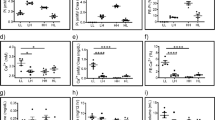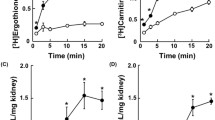Abstract
Rats were placed on a normal taurine diet (NTD), low taurine diet (LTD) or a high taurine diet (HTD) for 14 days. β-Alanine was fed to half of the animals in each group and resulted in a lowered renal cortex taurine content. Brush border membrane vesicle (BBMV) uptake of taurine was higher after β-alanine feeding and was associated with an increase in Vmax of uptake. β-Alanine feeding to HTD animals also altered the Km of uptake, possibly since the load of sulfur amino acids (6% of diet) was high. As a control, glycine (3%) feeding for 8 days along with each diet did not alter the plasma or renal cortex content; BBMV uptake as well as Km and Vmax of taurine accumulation were minimally altered. Accordingly, ingestion of a non-sulfur-containing α-amino acid did not change β-amino acid transport. This study provides evidence that whole body taurine homeostasis is maintained in the presence of a taurine-depleting agent (β-alanine feeding) by an increase in the number of Na+-taurine uptake sites.
Similar content being viewed by others
References
Friedman AL, Albright PW, Chesney RW (1981) Dietary adaptation of taurine transport by rat renal epithelium. Life Sci 29: 2415–2419
Friedman AL, Albright PW, Gusowski N, Padilla M, Chesney RW (1983) Renal adaptation to alteration in dietary amino acid intake. Am J Physiol 245: F159-F166
Rozen R, Scriver CR (1982) Renal transport of taurine adapts to perturbed taurine homeostasis. Proc Natl Acad Sci USA 79: 2101–2105
Chesney RW, Friedman PW, Albright PW, Gusowski N (1982) Fasting reverses the renal adaptation to altered dietary amino acid intake. Proc Soc Exp Biol Med 170: 493–501
Chesney RW, Gusowski N, Friedman AL (1983) Renal adaptation to altered dietary sulfur amino acid intake occurs at luminal brush border membrane. Kidney Int 24: 588–594
Shaffer JE, Kocsis JJ (1981) Taurine mobilizing effects of β-alanine and other inhibitors of taurine transport. Life Sci 28: 2727–2736
Sturman JA, Hayes KC (1980) The biology of taurine in nutrition and development: In: Draper HH (ed) (ed) Advances in nutrition research, vol 3. Plenum Publishing Corp, New York, pp 231–299
Chesney RW (1985) Taurine: Its biological role and clinical implications. In: Barness LA (ed) Advances in pediatrics, vol 32. Chicago Year Book Medical Publishers, Chicago, pp. 1–42
Chesney RW, Gusowski N, Dabbagh S (1985) Renal cortex taurine content regulates renal adaptive response to altered dietary intake of sulfur amino acids. J Clin Invest 76: 2213–2221
Chesney RW, Jax DK (1979) Developmental aspects of renal β-amino acid transport: I. Ontogeny of taurine reabsorption and accumulation in renal rat cortex. Pediatr Res 13: 854–860
Booth AG, Kenny AJ (1974) A rapid method for the preparation of microvilli from rabbit kidney. Biochem J 142: 575–581
Glossman H, Neville DM, Jr (1972) γ-glutamyl transferase in kidney brush border membranes. FEBS Lett 19: 340–344
Dixon TF, Purdom M (1954) Serum 5-nucleotidase. J Clin Pathol 7: 341–343
Lowry OH, Rosebrough NJ, Farr AL, Randall RJ (1951) Protein measurement with the folin phenol reagent. J Biol Chem 193: 265–275
Chesney RW, Sacktor B, Rowen RR (1973) The binding of D-glucose to the isolated rabbit renal brush border. J Biol Chem 218: 2182–2191
Neal JL (1972) Analysis of Michaelis kinetics for two independent saturable membrane transport functions. J Theor Biol 35: 113–118
Hayes KC, Carey RE, Schmidt SY (1975) Retinal degeneration associated with taurine deficiency in the cat. Science 189: 949–951
Sturman JA, Wen GY, Wisniewski HM, Neuringer MD (1984) Retinal degeneration in primates raised on a synthetic human infant formula. Int J Dev Neurosci 2: 121–129
Rigo J, Senterre J (1977) Is taurine essential for the neonate? Biol Neonate 32: 73–76
Gaull GE, Rassin DK, Räihä NC, Heinonen K (1977) Milk protein quantity and quality in low-birthweight infants III. Effects on sulfur amino acids in plasma and urine. J Pediatr 90: 348–355
Geggel HS, Ament ME, Heckelively JR, Martin DA, Kopple JD (1985) Nutritional requirement for taurine in patients receiving long-term parenteral nutrition. N Engl J Med 312: 142–146
Zeukovic I, Chesney RW: Interpersonal communication
Cooper A, Betts JM, Pereira GR, Ziegler MM (1984) Taurine deficiency in the severe hepatic dysfunction complicating total parenteral nutrition. J Pediatr Surg 19: 462–466
Cooke RJ, Whitington PF, Kelts D (1984) Effect of taurine supplementation on hepatic function during shortterm parenteral nutrition in the premature infant. J Pediatr Gastroenterol Nutr 3: 224–238
Sturman JA, Hayes KC (1980) The biology of taurine in nutrition and development. Adv Nutr Res 3: 231–299
Lombardini JB (1985) Opposite effects of α-amino ethanesulfonic acid (taurine) and aminomethanesulfonic acid on calcium ion uptake in rat retinal preparations. Eur J Pharmacol 110: 385–387
Lombardini JB (1985) Taurine effects the transition temperature in Arrhenius plots of ATP-dependent calcium ion uptake in rat retinal membrane preparations. Biochem Pharmacol 34: 3741–3745
Weiss SJ, Klein R, Slivka A, Wei M (1982) Chlorination of taurine by human neutrophils: Evidence for hypochlorous acid generation. J Clin Invest 70: 598–607
Test ST, Lampert MB, Ossanna PJ, Thoene JB, Weiss SF (1984) Generation of nitrogen-chlorine oxidants by human phagocytes. J Clin Invest 74: 1341–1349
Persantes-Morales H, Cruz CJ (1984) Protective effect of taurine and zinc on peroxidation-induced damage in photoreceptor outer segments. J Neurosci Res 11: 303–311
Pasantes-Morales H, Wright CE, Gaull GE (1984) Protective effects of taurine, zinc, and tocopherol on retinol-induced damage in human lymphoblastoid cells. J Nutr 114: 2256–2261
Kerwin RW, Pycock CJ (1979) Role of taurine as a possible transmitter in the thermoregulatory pathways of the rat. J Pharm Pharmacol 31: 466–470
Garcia de Yebenes Prous J, Carlsson A, Mena Gomez MA (1978) The effect of taurine on motor behavior, body temperature and monoamine metabolism in rat brain. Naunyn-Schmiedeberg's Arch Pharmacol 304: 95–99
Scheibel J, Elsasser T, Brown B, Dom R, Ondo JG (1984) The stimulation of prolactin secretion by taurine: studies on the site of action. Brain Res Bull 13: 49–52
Hanretta AT, Lombardini JB (1985) Effects of intrahypothalamic kainic acid injection on taurine levels, binding and uptake. Brain Res 338: 351–354
Schrock J, Forster RP, Goldstein L (1982) Renal handling of taurine in marine fish. Am J Physiol 242: FR64-FR71
Thurston JH, Haubart RE, Dugo JA (1980) Taurine, a role in osmotic regulation of mammalian brain and possible clinical significance. Life Sci 26: 1561–1565
Forster RP, Goldstein L (1979) Amino acids and cell volume regulation. Yale J Biol Med 52: 497–519
Chesney RW, Lippincott SE, Gusowski N, Padilla M, Zelikovic I (1986) Studies on renal adaptation to altered dietary amino acid intake: tissue taurine responses in nursing and adult animals. J Nutr (in press)
Mitch WE, Chesney RW (1983) Amino acid metabolism by the kidney. Miner Electrolyte Metab 9: 190–202
Scriver CR, Chesney RW, McInnes RR (1976) Genetic aspects of renal tubular transport: diversity and topology of carriers. Kidney Int 9: 149–171
Silbernagl S, Foulkes EC, Deetjen P (1975) Renal transport of amino acids. In: Reviews of physiology, biochemistry and pharmacology, vol 74. Springer, Berlin Heidelberg New York, pp 105–167
Segal S, Their SO (1973) Renal handling of amino acids. In: Handbook of physiology, American Physiological Society. Williams & Wilkins, Washington, pp 653–676
Young JA, Freedman BS (1971) Renal tubular transport of amino acids. Clin Chem 17: 245–266
Grosvenor MB, Zeman FJ (1983) In vitro amino acid transport by renal tubules of prenatally protein-deprived fetal rats. J Nutr 113: 1513–1520
Coates ME, O'Donoghue DN, Doyne PR, Ward RJ (eds) (1969) Dietary standards for laboratory rats and mice; In: Laboratory animal handbook No. 2. Laboratory Ltd, London
Author information
Authors and Affiliations
Additional information
Supported in part by grants from NIH RO1 AM 31682-02, AM 37223-01 and the Medical School and Graduate School Research Committees of The University of Wisconsin. Dr. Dabbagh is supported by the Pearl M. Stetler Foundation. Dr. Chesney was the recipient of a Research Career Development Award KO4 AM 00421.
Rights and permissions
About this article
Cite this article
Chesney, R.W., Gusowski, N. & Dabbagh, S. Studies on renal adaptation to altered dietary amino acid intake: reduced renal cortex taurine content increases the Vmax of taurine uptake by brush border membrane vesicles. Pediatr Nephrol 1, 9–15 (1987). https://doi.org/10.1007/BF00866878
Received:
Revised:
Accepted:
Issue Date:
DOI: https://doi.org/10.1007/BF00866878




